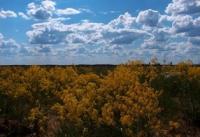You are here
Global section of Aidarlyasha.





Travels of the nature of Aktyubinsk region.
“True love is like a ghost. Everyone is talking about her, but no one has seen her”
Nature Aktyubinsk region.
At the beginning of the XXth century, ashore of the river geologist paleontologist found the shells of cephalopods in the stones, and heir age was 350 million years. It confirmed the surmise of the scientists, that those times there were rivers on the place of the Kazakhstan steppes.
The opening of the unique geological section Aidarlyasha, named by the river, became a sensation in the science. As a result of stratum motion of the earth’s crust, 40 layers of the earth’s crust, formed 350 - 290 million years ago were horizontally ousted on the surface of the earth.
Remains of the plant and animals from those periods, kept in Aidarlyasha are available for viewing and learning. Here are preserved remains of plants and animals far that flowed millions of years ago the transition period available for review and study.
The unique location of the fossil organic remains, which in the context of distributed unevenly. In the lower part of the section are distributed mainly in fusulinids and conodonts, ammonoids are rare. Ammonoids – the Ammonites, an extinct subclass of cephalopods. Known from the Devonian to the late Cretaceous around the globe. About 1,500 species. Predators.
Dwelt in the seas. Conodonts – fossils of animals, systematic whose origin is not clear. Fusulinid – detachment of extinct foraminifera. Lived in Carboniferous and Permian periods. In 1996 at the international Congress of geologists, held in Beijing, he was awarded the status of a global stratotype.
In 2005 he was inducted into the national list of specially protected natural territories (SPNT). In Aktobe region there are three geomorphological object state natural reserve Fund. Hydrolyase stratotype is located on the banks of the river, somewhere on the border of Kyzylzhar rural district of Aktobe and Khromtau district and is a cliff with a height of about 50 meters.
The section is not a cliff, and almost vertical slope of the hill bordering the river from the North, and looked impressive. However, he would hardly have attracted the attention of the uninitiated. A scattering of rocks crumbling rocks did not indicated that the context of Aydarliasha was formed about 290 - 350 million years ago.
Then in the Permian period as a result of shifts in the earth's crust 40 layers was extruded from the depths of the earth and deployed in a horizontal position. Holding now some ordinary "stone", it's hard to imagine that he, more than 300 million years.
According to the famous Aktobe geologist, honored explorers RK Rostislav Segedina, the upper layers of Aydarliasha represent conglomerates Artinskian of the layer of the lower Permian, and oddly curved seams down the slope – it exits the upper Carboniferous mudstones and limestones.
The uniqueness of the incision in the fact that in the layers you can find the remains of animals that lived at that time, including shark teeth. The finds in the town of Aydarliasha is a vivid testament to the fact that on the territory of our region splashed tropical sea and amazing animals lived.
Not in vain the context of Aydarliasha has universal significance. It not only is valuable as a monument of nature, but also allows scientists to peer into the depths of time, keep track of the processes taking place in the era of the Perm.
It was one of the most difficult periods in the history of the Earth: land elevations was, collapsed one mountain and up the other. Aydarliasha is one of the "echoes" of that era. Valley to Aydarliasha – unique location of fossil organic remains, with its exceptional preservation.
The cut boundary layers of Carboniferous and Permian carries information about the conditions of sedimentation, climate, level of development of life of a particular place and time. The incision is of scientific importance for professionals in the fields of biology, Geology, can serve as a place for training practices and excursions for students of geological and biological Sciences, and also be subject to geological tourism.
Authority:
The encyclopedia of Kazakhstan, 1996. and the material for this page is taken from the printed edition."Guide to Kazakhstan"







